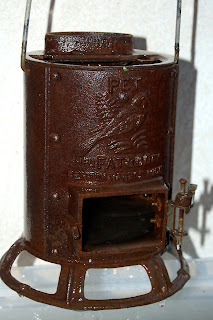 |
| www.fatscostoves.com |
I found one of these little cuties on eBay for around 50 bucks several years ago-- long before I ever thought I'd be in a position to build a boat. I bought it rather hopefully anyway. Lugging it to various apartments year after year as I finished college, I dreamed of the day I would warm my hands around its tiny crackling fire while moored in a Norwegian fjord.
In January 2010, when I finally mustered the guts to get going on the boat project, I dragged it out of its box and found that it was completely encrusted in rust. The tiny door even broke off in my hand when I tried to open it. A major restoration was needed.
I decided that old-fashioned elbow grease and a wire brush were for the birds on this project. I was going to zap the rust off that thing. More technically, it is possible to electrolytically remove the rust by reducing the iron oxide Fe2O3 (aka red rust) to Fe3O4 (aka black rust), which detaches from the underlying iron and flakes off really easily. My brother Logan was visiting at the time, so we figured that if one of us got electrocuted, at least the other was there to make the drive to the county hospital.
Basically, you get a trickle battery charger, attach the positive lead to a sacrificial anode and the negative lead to your rusted piece. This needs to be done in an electrolyte bath--- "Arm and Hammer All Natural Super Washing Soda" works best for this. Make SURE that the alligator clip attached to your anode doesn't get in the bath, because it'll rust the clip pretty badly.
This site describes the process in detail.
 |
| Note that the alligator clip on the sacrificial anode is up and out of the electrolyte solution. You don't want to sacrifice your clip, too. |
After all of that my little Fatsco stove looked pretty good. I applied some stove polish and burned a little wood fire in it. I'll include photos of the finished 'restoration' when I receive the replacement door, latch, and hinges.
 | ||||||||
| The little brother suggested we "capture the hydrogen and blow it up." I nixed that idea. |


































